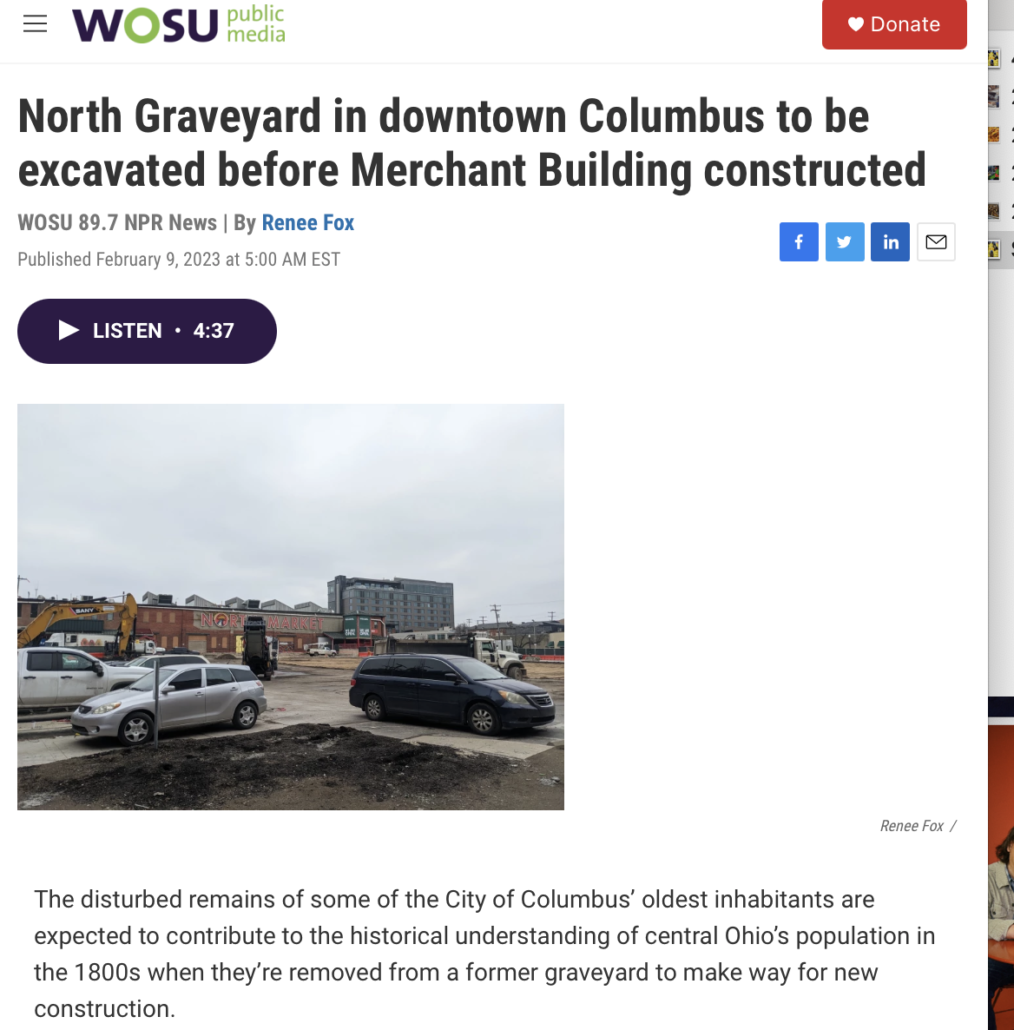The disturbed remains of some of the City of Columbus’ oldest inhabitants are expected to contribute to the historical understanding of central Ohio’s population in the 1800s when they’re removed from a former graveyard to make way for new construction.
Archaeologists are due to start excavating a plot in the North Market’s parking lot before the Merchant Building is constructed. The building will be a new skyscraper with more than 30 floors, that will include a hotel and parking garage.
The original cemetery was bordered by Spruce Street to the north, High Street to the east, Park Street to the west and Convention Center Drive to the south.
The site was once home to one of the city’s first graveyards and many bodies remain underground.
The 1-acre site in front of the North Market is a prime location in one of the city’s prime neighborhoods. Two hundred years ago, it was part of the North Graveyard before development encroached.
The 10-acre North Graveyard was one of five original cemeteries built when Columbus began to expand at the beginning of the 19th century. It may be hard to believe, but the location was outside the city’s center at the time.
“Then it became really an urban cemetery as Columbus grew and grew and grew,” said Krista Horrocks, a project review manager at the State Historic Preservation Office at the Ohio History Connection. “These areas became more desirable, where the cemeteries were, due to urban development.”
People wanted the space to build, and they didn’t want cemeteries in the middle of town. They were seen as unsanitary and could be treated like parks in outlying areas.
“In the early to mid-1800s, people lived side by side with their livestock here, even in areas like Columbus. So we see stories (published in) early newspapers about cows and pigs running through the cemetery causing a mess,” Horrocks said.
In the middle of that century, city officials asked people to stop burying their dead there in the public cemetery, and started moving the bodies.
But the process was imperfect.
People kept burying their dead there even after the city banned it.
“It was out of desperation likely that people would come in the middle of the night and bury their loved ones. And so there’s just papers, articles that talk about that ‘a Sexton came in and saw three new burials today’ and things like that,” Horrocks said.
The covert burials made it difficult to relocate remains. Workers often missed graves and left behind some material during disinterment. Other graves were left because people did not claim the bodies or they were no longer marked. While the city relocated hundreds of graves over several decades, many bodies remained underground.
“Their attempts to move people in 1881 were honorable, they did their best, but it’s by no means an archaeological investigation, like today,” Horrocks said.
People began building over the area at the beginning of the 20th century, and surely came across remains then, too, according to Horrocks.
The reality of just how much was left behind and built upon came to light in 2001, when Ryan Weller was observing an excavation in the area for a sewer line project. He recounted the experience in a 2016 interview with WOSU.
“We didn’t expect anything, so we’re digging underneath pavement. And that’s when the history started to come into perspective. Like wow, the cemetery’s still here,” Weller said.
They found complete skeletons and partial ones.
“One day I get a call on my cellphone and he goes ‘get down here quick? Two arms just fell into the trench,” Weller said.
The remains of about 40 people were found along Spruce Street.
The Merchant Building proposal was selected in 2017, and archaeologists have been involved in the process because of the history of the site.
The city began removing remains as it started digging for utility infrastructure last year.
Justin Zink is a leader for cultural resources at Lawhon and Associates, the firm managing the archeological process for the project. He said the team identified grave shafts and then “respectfully and ethically” removed the remains.
There they found remains belonging to more than 40 people buried in 40 graves shafts, along with items including buttons, coffin nails and coffin hinges.
The recovered material will be stored until it is analyzed, and the bones are examined by an osteologist. Researchers will look for clues to paint a picture that could include information about the descendants’ race, age, sex, health and socioeconomic status.
Zink said when the work is complete, it will be detailed in a public report. “I think interesting components are going to come out at the end, once we get all of that information. Do we have something unique that we can tell about the early history of the city of Columbus, based on this burial population and this window in the time?” he said.
Horrocks said the remains of the people left behind at the site deserve a proper burial. “It’d be really great to finally properly be able to honor and memorialize the people that were left behind unfortunately,” she said.
All of the remains and other items recovered from the excavations will be interred in Greenlawn Cemetery following the study.









